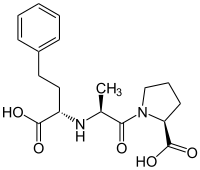Enalaprilat
 | |
| Systematic (IUPAC) name | |
|---|---|
| (2S)-1-[(2S)-2-{[(1S)-1-carboxy-3-phenylpropyl]amino}propanoyl]pyrrolidine-2-carboxylic acid | |
| Clinical data | |
| AHFS/Drugs.com | monograph |
| Licence data | US FDA:link |
| Identifiers | |
| 76420-72-9 | |
| ChemSpider | 4575429 |
| UNII |
GV0O7ES0R3 |
| ChEBI | CHEBI:4786 |
| ChEMBL | CHEMBL577 |
| Chemical data | |
| Formula | C18H24N2O5 |
| 348.4 g/mol | |
|
SMILES
| |
| |
Enalaprilat is the active metabolite of enalapril. It is the first dicarboxylate-containing ACE inhibitor and was developed partly to overcome these limitations of captopril. The sulfhydryl-moiety was replaced by a carboxylate-moiety, but additional modifications were required in its structure-based design to achieve a similar potency to captopril.
Enalaprilat, however, had a problem of its own. The consequence of the structural modifications was that it proved to have unfavourable ionisation characteristics to allow sufficient potency for oral administration (in tablets). Thus, enalaprilat was only suitable for intravenous administration. This was overcome by the esterification of enalaprilat with ethanol to produce enalapril.
As a prodrug, enalapril is metabolized in vivo to the active form enalaprilat by various esterases. Peak plasma enalaprilat concentrations occur 2 to 4 hours after oral enalapril administration. Elimination thereafter is biphasic, with an initial phase which reflects renal filtration (elimination half-life 2 to 6 hours) and a subsequent prolonged phase (elimination half-life 36 hours), the latter representing equilibration of drug from tissue distribution sites.
The prolonged phase does not contribute to drug accumulation on repeated administration but is thought to be of pharmacological significance in mediating drug effects. Renal impairment [particularly creatinine clearance < 20 ml/min (< 1.2 L/h)] results in significant accumulation of enalaprilat and necessitates dosage reduction. Accumulation is probably the cause of reduced elimination in healthy elderly individuals and in patients with concomitant diabetes, hypertension and heart failure. [1][2]